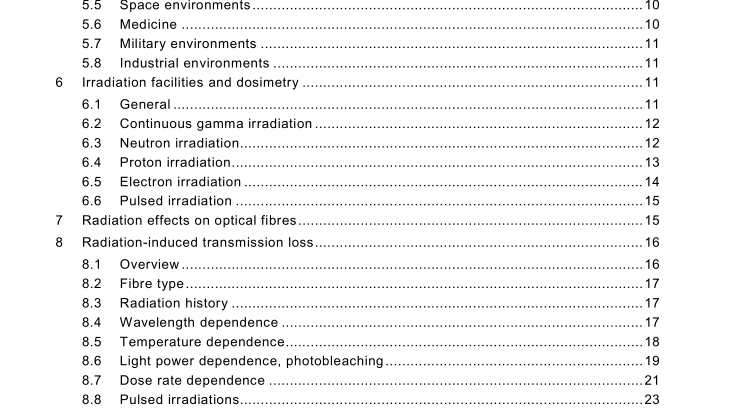IEC TR 62283:2010 pdf download – Optical fibres – Guidance for nuclear radiation tests
4 Radiation shielding
Shielding of optical fibres against (especially gamma) radiation is in most cases not reasonably achievable since, for example, gamma rays of 1 MeV are attenuated to 1 /1 0 of their initial intensity only by 5 cm of lead. However, buried fibre cables that are layed in at least 1 m depth are shielded against 1 MeV gamma rays by about a factor of 1 0 4 .
5 Radiation environments and exposure
5.1 Natural radioactivity
The predominant radiation type is gamma rays. Typical annual dose value for earth cables or undersea cables is <0,004 Gy. The total dose during an expected cable lifetime of 25 years would thus be <0,1 Gy. Distinctly higher values are possible, for example, above uranium or thorium ore deposits. The dose and dose rates are typical and may vary depending on the specific application.
5.2 Nuclear reactors (fission) Optical fibres can be exposed to gamma rays as well as to thermal and fast neutrons. Dose and fluence values depend strongly on the place within the reactor building and the operating conditions of the reactor (for example the power delivery, normal operation or accident). Within the containment area, exposure levels range from 0,001 Gy/h to 0,03 Gy/h up to about 1 Gy/h near the primary coolant lines. The dose rate around the fuel rods is of the order of 1 0 3 Gy/h. In the early stage of an accident, dose rates as high as 1 0 4 Gy/h will occur within the containment [4]. The neutron flux (= fluence Φ per unit of time) within the containment can range from about 1 0 cm –2 s –1 up to about 1 0 1 2 cm –2 s –1 near the fuel rods. The dose, dose rates and neutron fluence are typical and may vary depending on the specific application.
5.3 Fusion reactors
The primary radiation emitted after the fusion of deuterium (D) and tritium (T) nuclei are 1 4 MeV neutrons and 4 He nuclei (energy about 3,5 MeV). The 4 He ions are very short-ranged and will not reach optical fibres that might be used as sensors or to transfer data, whereas the fast neutrons are very penetrating and will also activate the structural materials around the reaction chamber. These materials then emit high gamma ray intensities also after reactor turn-off. Again, the total dose and neutron fluence values depend strongly on location and operation conditions. For the future test facility ITER (International Thermonuclear Experimental Reactor), gamma dose rates at the first wall of about 2×1 0 2 Gy/s and life dose values of 1 0 7 Gy to 1 0 9 Gy are expected. The neutron fluence there could reach values up to 1 0 20 cm – 2 .
At inertial confinement fusion (ICF) facilities such as "Laser Megajoule" (France) or "National Ignition Facility" (USA) diagnostic equipment, comprising also optical fibres, is exposed to pulsed radiation of up to 1 0 3 Gy at dose rates up to 1 0 1 0 Gy/s. The dose and dose rates are typical and may vary depending on the specific application.
5.4 High-energy physics experiments Usually, in high-energy physics, electrons or protons with energies as high as several 1 00 GeV (protons) are used to study elementary particles. In order to increase the reaction energy it is common that two beams collide within a reaction zone which is surrounded by huge detectors analyzing the reaction products.
The accelerator tube and the inner parts of the detectors will become highly radioactive, especially if protons collide. The secondary radiation that threatens the accelerator control instruments and the detector read-out equipment mainly consists of pions (mean energy several 1 00 MeV), gamma rays and, at radii >50 cm, of neutrons with maximum energies up to more than 1 00 MeV, but a mean energy of only about 1 MeV to 2 MeV. The radiation intensities strongly depend on the operating conditions (particle energy, beam current), the distance from the beam line, and the emission angle (maximum in beam direction). Particularly in the beam cleaning sections, high radiation levels may occur.
The annual total dose can be of the order of 1 0 5 Gy to 1 0 6 Gy and the neutron fluence can reach values from 1 0 1 3 cm −2 to 1 0 1 5 cm −2 . The dose and dose rates are typical and may vary, depending on the specific application.
